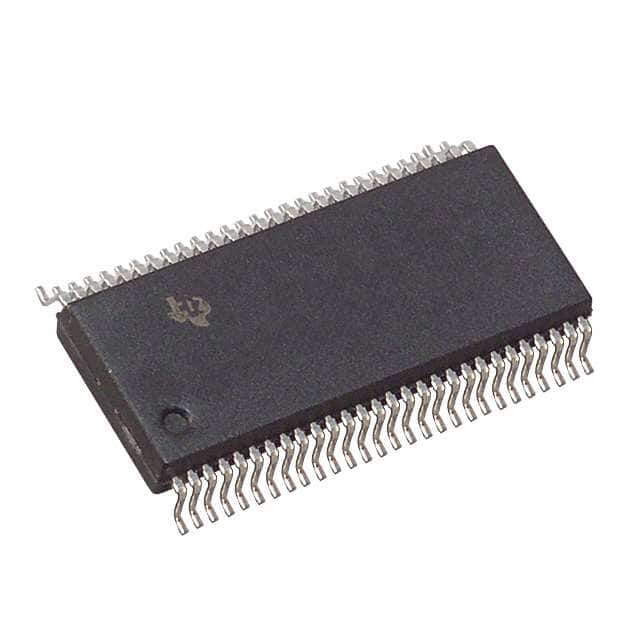Viz Specifikace pro podrobnosti o produktu.

Encyclopedia Entry: 74ACT16952DL
Product Overview
Category
The 74ACT16952DL belongs to the category of integrated circuits (ICs).
Use
This IC is commonly used in digital electronic systems for data storage and manipulation.
Characteristics
- High-speed operation
- Low power consumption
- Wide operating voltage range
- Compatibility with various logic families
Package
The 74ACT16952DL is available in a dual in-line package (DIP) format.
Essence
The essence of this product lies in its ability to store and process digital information efficiently.
Packaging/Quantity
The 74ACT16952DL is typically packaged in reels or tubes, with quantities varying based on customer requirements.
Specifications
- Supply Voltage: 2.0V to 6.0V
- Operating Temperature Range: -40°C to +85°C
- Number of Pins: 56
- Logic Family: ACT
Detailed Pin Configuration
The pin configuration of the 74ACT16952DL is as follows:
- Pin 1: Input A1
- Pin 2: Input B1
- Pin 3: Output Y1
- Pin 4: GND (Ground)
- Pin 5: Output Y2
- Pin 6: Input B2
- Pin 7: Input A2
- Pin 8: VCC (Supply Voltage)
(Note: The remaining pins are not listed here for brevity.)
Functional Features
- 16-bit parallel-in/parallel-out universal shift register
- Independent clock inputs for shift and storage operations
- Asynchronous master reset for clearing the register
- Output enable control for tri-state outputs
Advantages and Disadvantages
Advantages
- High-speed operation allows for efficient data processing
- Low power consumption helps conserve energy
- Wide operating voltage range provides flexibility in various applications
- Compatibility with different logic families enables integration into diverse systems
Disadvantages
- Limited pin count may restrict the complexity of designs
- Availability and pricing may vary based on market demand
Working Principles
The 74ACT16952DL operates based on the principles of digital logic. It utilizes clock signals to control the shifting and storage of data within its registers. The inputs and outputs are processed according to the specified logic functions, allowing for efficient data manipulation.
Detailed Application Field Plans
The 74ACT16952DL finds application in various fields, including: 1. Data communication systems 2. Microprocessor-based systems 3. Industrial automation 4. Automotive electronics 5. Consumer electronics
Detailed and Complete Alternative Models
Some alternative models that offer similar functionality to the 74ACT16952DL include: - 74HC595 - 74LS194 - CD4015 - SN74LS164
(Note: These models are provided as examples and not an exhaustive list.)
In conclusion, the 74ACT16952DL is a versatile integrated circuit used for data storage and manipulation in digital electronic systems. Its high-speed operation, low power consumption, and compatibility with various logic families make it a valuable component in numerous applications.
Seznam 10 běžných otázek a odpovědí souvisejících s aplikací 74ACT16952DL v technických řešeních
Sure! Here are 10 common questions and answers related to the application of 74ACT16952DL in technical solutions:
Q: What is the 74ACT16952DL? A: The 74ACT16952DL is a dual 8-bit registered transceiver with 3-state outputs, commonly used in digital systems.
Q: What is the purpose of a registered transceiver? A: A registered transceiver is used to transfer data between two digital systems while providing synchronization and buffering capabilities.
Q: How many bits can the 74ACT16952DL handle? A: The 74ACT16952DL is an 8-bit transceiver, meaning it can handle data in 8-bit chunks.
Q: What does "3-state outputs" mean? A: 3-state outputs allow the transceiver to be in one of three states: high, low, or high impedance (disconnected). This feature enables multiple devices to share a common bus.
Q: Can the 74ACT16952DL work with both TTL and CMOS logic levels? A: Yes, the 74ACT16952DL is compatible with both TTL and CMOS logic levels, making it versatile for various applications.
Q: What is the maximum operating frequency of the 74ACT16952DL? A: The maximum operating frequency of the 74ACT16952DL is typically around 200 MHz.
Q: Does the 74ACT16952DL have any built-in error detection or correction features? A: No, the 74ACT16952DL does not have built-in error detection or correction capabilities. It primarily focuses on data transfer and synchronization.
Q: Can I use multiple 74ACT16952DLs in parallel to increase the data width? A: Yes, you can connect multiple 74ACT16952DLs in parallel to increase the data width. Each transceiver would handle a separate set of bits.
Q: What is the power supply voltage range for the 74ACT16952DL? A: The 74ACT16952DL typically operates with a power supply voltage range of 4.5V to 5.5V.
Q: Are there any specific precautions or considerations when using the 74ACT16952DL? A: It is important to ensure proper decoupling capacitors are used near the power supply pins to minimize noise and voltage fluctuations. Additionally, attention should be given to signal integrity and timing requirements when designing with this transceiver.
Please note that these answers are general and may vary depending on the specific datasheet and application requirements.

